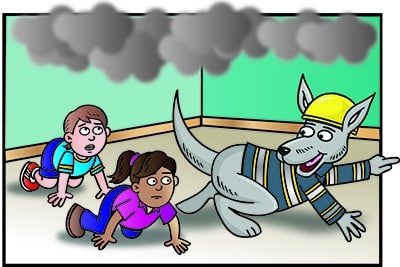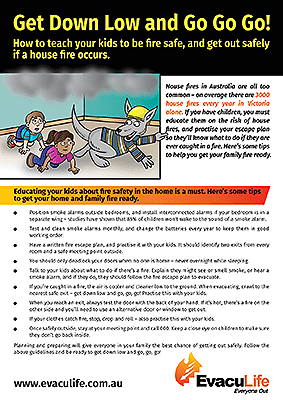
How to teach your kids to be fire safe, and get out safely if a house fire occurs.

House fires in Australia are all too common – on average there are 3000 house fires every year in Victoria alone. If you have children, you must educate them on the risk of house fires, and practise your escape plan so they’ll know what to do if they are ever caught in a fire. Here are some tips to help you get your family fire ready.
Plan to Survive
Every home should have a written fire escape plan, and you should share and practise it with your kids. As a minimum, your escape plan should include at least two exit points from every room and a safe meeting place outside. It should also include measures for anyone with mobility limitations like babies, the elderly and those with a disability. Get your kids involved in making your plan, as this will help them remember what to do.
Identifying Danger
Be sure to teach your children how to identify the signs of a possible fire. Talk about smoke alarms and show them where they are located in your home. Explain about the other warning signs, such as seeing and smelling smoke. Let them know that if they hear an alarm or see a fire they should never, ever hide, but should call for help and quickly crawl to the nearest safe exit.
Getting Out Safely
The safest place in a fire is low to the ground, because the air is cooler and cleaner. That’s why we get down low and go, go, go! It’s a good idea to practise your fire escape plan with young children, making sure you all get down low and crawl to the nearest exit. Practising your fire escape plan with children is essential, because they’re more likely to remember what to do and less likely to panic if a fire is happening and they’re scared.
What if You Can’t Get Down Low?
If you or any members of your family have mobility impairments, they may not be able to get down low to escape. You’ll need to address this in your fire escape plan and include additional safety measures. Evacuation masks provide critical protection from smoke and fumes, and are potentially life-saving for those who can’t crawl below smoke. Evacuation chairs may also be needed if you live in a multistorey home.
Choosing Your Exit
Teach kids to crawl to the nearest exit, and feel the door with the back of their hand before opening it. If the door is hot, there may be a fire on the other side and they need to find another exit. An alternative exit could be a window or a door and should be identified in your fire escape plan. Once safely outside, they should go to the meeting point, and find a safe place to wait for help. Make sure they know to never go back inside.
Plan, Prepare and Practice
You can make your home as fire ready as possible by minimising hazards, but you can never completely eliminate the risk of a house fire happening. That’s why it’s essential that every home has a fire plan – and if you have children, you’ll need to practise it with them to help them learn. The more practise the better – it will be time well-spent if an emergency evacuation is ever needed in your home as it gives everyone in your family the best chance of getting out safely.
Download the Get Down Low and Go Go Go Fact Sheet
Over to You
Do you have some more fire safety tips to help kids evacuate safely? We’d love to hear them! Share with other readers on our Facebook page.
Get Down Low and Go Go Go Fact Sheet


